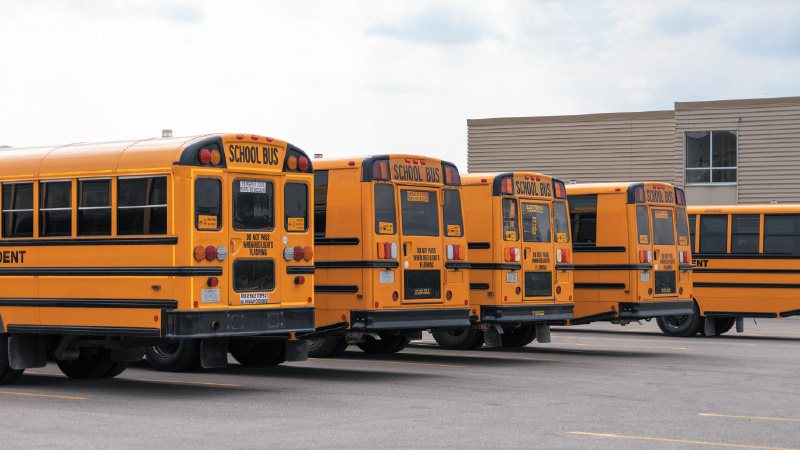Deborah Fonseca, Marketing and Communications Coordinator – Alberta Motor Transport Association
Yellow school bus, you have kept so many of us safe on Alberta roads for all these years.
Memories of leaving foot marks on the back of seats, the fight for the glorious back row, a finger-drawn stick person on the windows now and then. What more is there to say other than thank you? And to the wonderful bus drivers who greet us with a smile each day, thank you!
There is a lot more to buses than their yellow and black frames. School buses in Alberta undergo several safety implementations, consistent maintenance check-ins, and standardized driver training protocols.
These procedures achieve a common goal: keeping children and the public safe. This starts with the hiring process. Bus drivers complete a series of background checks, a driver’s abstract, and reference checks, followed by intensive safety training.
According to Sparksman Transportation President Mark Critch, buses are one of the safest places to be on the road.
According to the Transport Canada bus safety standards website, “Fatalities on school buses account for less than 0.1% of all motor vehicle-related fatalities in Canada. In the last decade, between 2009 and 2018, there was one school bus passenger fatality on Canadian roads.”
Transport Canada also stated that as of 2018, students are 80 times more likely to get to school safely on a bus than by car.
Construction requirements for school buses include body joint strength, rollover protection, structural integrity, bus window retention, release and emergency exit requirements, as well as pedestrian safety devices, brake systems, and stability control.
This high safety standard is a source of pride for drivers and contractors, as is the importance of the connection drivers have with students.
“[Drivers] are the first positive interaction [kids have], and they are the last person [kids] see before they see their parents,” said Katie Marchant, Area Safety Manager, First Canada ULC.
Safety structures are also implemented within school buses to prevent injury. For example, in the case of an incident, first responders assess the integrity of the black stripes on the sides of buses to see where potential injuries may be. Buses also have high seat backs to absorb shock, flashing lights, and a stop arm to express students’ loading and unloading.
First, Canada ULC uses proprietary software to assess driving patterns and student behaviour on buses, and a GPS is used to ensure buses are on time and en route. Marchant said that the software also assists in tracing vehicles that pass buses when it is illegal to do so. The systems are also meant to hold people accountable, bus drivers, students, and motorists alike.
Shevon Coram, Chair of the Alberta Student Transportation Advisory Council (ASTAC), said distracted driving has been the biggest threat to road safety in the past few years, and people are not acknowledging that buses are carrying children, the ‘precious cargo’ of our communities.
Buses have longer braking times, which can affect their responses in high-risk situations. Therefore, it is the responsibility of those behind the wheel to create space for them and be considerate when sharing the road.
Buses in Alberta do more than move children to school and back home again. They are also utilized to evacuate towns during wildfires or other extreme circumstances.
Advocacy plays an immense role in the progress and implementation of safety practices in the commercial transportation industry. Contractors are tasked with providing their employers with drivers and equipment up to safety standards. Marchant said that First Canada’s vehicles travel between BC, Saskatchewan, and Alberta, so if Alberta’s transportation standards are higher, they meet that standard to exceed standards in other provinces. This standardization across provinces, in turn, enforces the standardization of legislation across the country. It is also important for contractors, drivers, and employers to have the same expectations for safety to ensure the most professional transportation practices.
ASTAC and the Alberta School Bus Contractors’ Association (ASBCA) represent drivers in the province. Critch and Marchant said that their active participation in these associations has allowed further advocacy for drivers and safety.
Critch said that education is the most important aspect of attaining ultimate safety within the province. He added that bus drivers alone complete 37-40 hours of training to be licensed; this includes injury reduction, first aid, student management, and general bus safety. Critch explained contractors are audited periodically to ensure compliance and avoid any disturbance to the standardized provincial codes.
Simultaneously, First Rider programs have been implemented across Alberta to educate the youth and parents about school bus safety, rules, and loading and unloading procedures, said Kelli Pickett, Secretary of ASTAC.
“Drivers take so much pride in their jobs just knowing they’re taking kids safely home,” said Marchant.


 1-866-985-9791
1-866-985-9791



